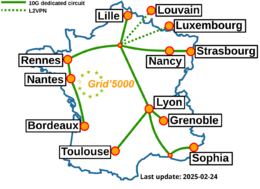Grid5000:Home
|
Grid'5000 is a precursor infrastructure of SLICES-RI, Scientific Large Scale Infrastructure for Computing/Communication Experimental Studies.
|
|
Grid'5000 is a large-scale and flexible testbed for experiment-driven research in all areas of computer science, with a focus on parallel and distributed computing, including Cloud, HPC, Big Data and AI. Key features:
Older documents:
|
Random pick of publications
Five random publications that benefited from Grid'5000 (at least 2786 overall):
- Jolan Philippe, Antoine Omond, Hélène Coullon, Charles Prud'Homme, Issam Raïs. Fast Choreography of Cross-DevOps Reconfiguration with Ballet: A Multi-Site OpenStack Case Study. SANER 2024: IEEE International Conference on Software Analysis, Evolution and Reengineering, Mar 2024, Rovaniemi, Finland. pp.1-11, 10.1109/SANER60148.2024.00007. hal-04457484 view on HAL pdf
- Alexandre Bonvoisin, Clément Quinton, Romain Rouvoy. Understanding the Performance-Energy Tradeoffs of Object-Relational Mapping Frameworks. SANER'24 - 31th IEEE International Conference on Software Analysis, Evolution and Reengineering, Mar 2024, Rovaniemi, Finland. pp.11. hal-04401643v2 view on HAL pdf
- Dorian Goepp, Fernando Ayats Llamas, Olivier Richard, Quentin Guilloteau. ACM REP24 Tutorial: Reproducible distributed environments with NixOS Compose. 2024, pp.1-3. hal-04613983 view on HAL pdf
- Louis Delebecque, Romain Serizel. BinauRec: A dataset to test the influence of the use of room impulse responses on binaural speech enhancement. EUSIPCO23, EURASIP, Sep 2023, Helsiinki, Finland. 10.23919/EUSIPCO58844.2023.10289772. hal-04193377 view on HAL pdf
- Marc Jourdan, Rémy Degenne, Emilie Kaufmann. An ε-Best-Arm Identification Algorithm for Fixed-Confidence and Beyond. Advances in Neural Information Processing Systems (NeurIPS), Dec 2023, New Orleans, United States. hal-04306214 view on HAL pdf
Latest news
The first SLICES-FR School is organized from July 7th to 11th in Lyon.
This free event, co-organized with the PEPR Cloud and Networks of the Future, brings together researchers, engineers and professionals to explore advances in distributed computing, edge computing, reprogrammable networks and the IoT.
-- Grid'5000 Team 09:30, 9 July 2025 (CEST)
![]() Cluster "vianden" is now in the default queue in Luxembourg
Cluster "vianden" is now in the default queue in Luxembourg
We are pleased to announce that the vianden[1] cluster of Luxembourg is now available in the default queue.
Vianden is a cluster of a single node with 8 MI300X AMD GPUs.
The node features:
The AMD MI300X GPUs are not supported by Grid'5000 default system (Debian 11). However, one can easily unlock full GPU functionality by deploying the ubuntu2404-rocm environment:
fluxembourg$ oarsub -t exotic -t deploy -p vianden -I
fluxembourg$ kadeploy3 -m vianden-1 ubuntu2404-rocm
More information in the Exotic page.
This cluster was funded by the University of Luxembourg.
[1] https://www.grid5000.fr/w/Luxembourg:Hardware#vianden
-- Grid'5000 Team 11:30, 27 June 2025 (CEST)
![]() Cluster "hydra" is now in the default queue in Lyon
Cluster "hydra" is now in the default queue in Lyon
We are pleased to announce that the hydra[1] cluster of Lyon is now available in the default queue.
As a reminder, Hydra is a cluster composed of 4 NVIDIA Grace-Hopper servers[2].
Each node features:
Due to its bleeding-edge hardware, the usual Grid'5000 environments are not supported by default for this cluster.
(Hydra requires system environments featuring a Linux kernel >= 6.6). The default system on the hydra nodes is based on Debian 11, but **does not provide functional GPUs**. However, users may deploy the ubuntugh2404-arm64-big environment, which is similar to the official Nvidia image provided for this machine and provides GPU support.
To submit a job on this cluster, the following command may be used:
oarsub -t exotic -p hydra
This cluster is funded by INRIA and by Laboratoire de l'Informatique du Parallélisme with ENS Lyon support.
[1] Hydra is the largest of the modern constellations according to Wikipedia: https://en.wikipedia.org/wiki/Hydra_(constellation)
[2] https://developer.nvidia.com/blog/nvidia-grace-hopper-superchip-architecture-in-depth/
-- Grid'5000 Team 16:42, 12 June 2025 (CEST)
![]() Cluster "estats" (Jetson nodes in Toulouse) is now kavlan capable
Cluster "estats" (Jetson nodes in Toulouse) is now kavlan capable
The network topology of the estats Jetson nodes can now be configured, just like for other clusters.
More info in the Network reconfiguration tutorial.
-- Grid'5000 Team 18:25, 21 May 2025 (CEST)
Grid'5000 sites
Current funding
INRIA |
CNRS |
UniversitiesIMT Atlantique |
Regional councilsAquitaine |




